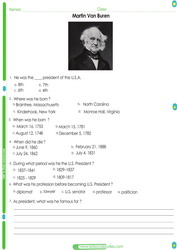Millard Fillmore facts for kids
Millard Fillmore Facts For Kids - social studies skills studied in 2nd, 3rd, 4th, 5th grades.
The 13th President of the USA
Millard Fillmore was the 13th President of the USA. He served the country from 1850-1853 in the capacity of the U.S. President.
Early Life
Fillmore was born on 7th January 1800 in the Locke Township of New York. He was born to Nathaniel Fillmore and Phoebe Millard. His family was extremely poor. When he turned 15, his father apprenticed him to a tailor to get some earning for the family. However, two years later he left the apprenticeship and went to New Hope in New York. During this time he became interested in educating himself. So he joined the New Hope Academy. Here he met Abigail Powers and the couple got married in 1826. Continue reading below>>>
Political Career
In the year 1819, Fillmore took up a job of a clerk under a local judge. In 1823, he got admission in the New York Bar. His political career started after joining the Anti-Masonic Party. In 1828, he became an elected member of the State Assembly of New York and served three terms. Later in 1832, he got elected to the House of Representatives. He supported the abolition of slave trade among the states and upheld the policy of ‘protective tariff’.
Millard Fillmore later joined the Whig Party. Around 1843, he made several attempts to strengthen his political career. He helped in the establishment of the University at Buffalo in the year 1846. He became the first chancellor of this University. In 1847, he won the election for the reputable post of Comptroller of New York; his main responsibility was to revise the banking system of New York.
In the year 1848, Fillmore ran for the position of Vice President with Zachary Taylor as the presidential candidate. Both won the election, but they did not get along well. Hence, Fillmore was kept away from playing any important role.
However, President Taylor’s sudden death led to a turn in situations. Fillmore had to take the deceased President’s post until the next election. The entire cabinet of Taylor resigned, hoping Fillmore would request them to stay back. Instead, he accepted their resignations. He supported Stephen Douglas (Democratic Senator) for a number of bills. These bills later became the Compromise of 1850 which got passed; this only prolonged the divide in the Union.
Fillmore took some significant decisions on the foreign policy as well. He ordered the dispatch of Commodore Matthew C. Perry to “open” Japan to trade relations with the west. He also opposed the influence of Europe in the Hawaiian Islands. He did not support the Southern powers in their desire to invade Cuba. Fillmore supported the Fugitive Slave Act as well. All these measures made him quite unpopular among many. In 1852, the Whig Party passed him over for a re-nomination.
Later Years
When the Whig Party was disintegrated, Fillmore did not join the Republican Party. He joined the American Party to run for the post of President. However, he did not succeed. Later he retired from the politics.
Fillmore had always voiced his opinions on the political matters of the country. He criticized President Buchanan for failing to take immediate action during the secession of South Carolina in 1860. During the Civil War, he opposed President Abraham Lincoln’s “unconditional policies” against the South.
Fillmore died on 8th March 1874 in Buffalo, New York.




